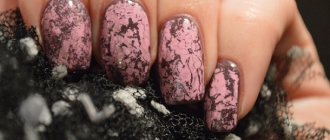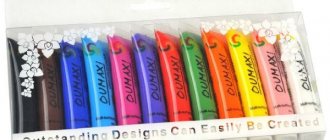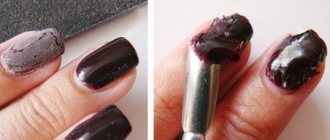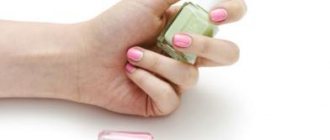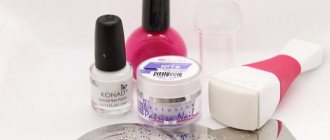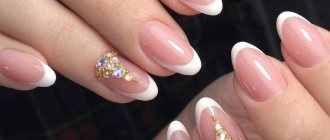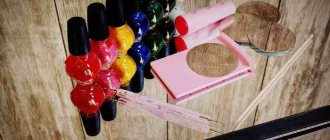The easiest way to get well-groomed, beautiful nails that will delight your eyes for up to three weeks is to get a manicure using gel polish.
This procedure has gained an army of fans in a very short time. Many people perform it in a beauty salon so often that they forget how important it is to plan a break between coats to restore the structure of the nails. During this period of “vacation from shellac”, you can strengthen your nails using the IBX system from Famous Names. And after the break, for additional protection of the nail, continue using IBX preparations, applying them under gel polish.
In addition to undoubted practicality and excellent appearance, a manicure with gel polish is also economical. Especially if you do the coating yourself at home. To do this, you just need to purchase the necessary materials and tools, as well as practice a little. Want to know how to apply shellac? Read on!
Necessary materials
The shopping list may immediately seem quite impressive. Therefore, if you decide to do your own gel polish coating, first think about whether such expenses will pay off for you in comparison with regular trips to the salon. If you still want to master the procedure yourself, you should purchase the following materials:
- Set for manicure and nail treatment,
- Equipment (lamp and, if desired, some others),
- Consumables,
- Base, top, primer and gel polishes,
- Materials for nail design.
To clarify, let's look at each point separately.
Tools
It is better to purchase tools in a professional store for manicurists. This way you will be sure that it is new and well sharpened. Nowadays it’s very easy to do this online: you can buy everything in one place, choose a palette, read reviews, look for cheaper prices and get your order delivered.
To perform a manicure you will need the following tools:
• Cuticle pusher (also called a spatula or scraper). This tool is needed to lift and push back the cuticle. An orange nail stick is often used as an alternative to a pusher. Its price is much lower, but it is a disposable tool, which is more likely to be consumable.
• Mills. They are needed only for hardware manicure with gel polish and removing long-term coating using a machine. For classic manicure, cutters are not used. A set of attachments along with the device is rarely purchased for independent use at home, since training is required to use it correctly. And the cost of the device is not so small.
• Nippers and/or nail scissors. They are used in classic and combined (using a machine) manicure to cut off raised cuticles. What is better to use, wire cutters or scissors, you can only determine by trying both at work - the choice is individual.
Thus, the only mandatory tools for processing the cuticle when performing a manicure followed by gel polish coating at home are a pusher and nippers/scissors. Don’t rush to buy cutters with a machine at the initial stage. Even experienced professionals recommend first learning how to perform a classic edged manicure.
Manicure ideas
On this topic:
Geometry on nails: main types, fashion ideas
When working, you can also give free rein to your imagination and make various designs on your nails.
Some of the simplest nail design ideas that you can do yourself at home:
- Using multiple colors has now become fashionable when nails are painted in different shades, when only one or even a combination of colors on one finger stands out. In addition, you can use a thin brush and use it to paint on your nails.
- Decoration with rhinestones or stones - a plain or colored manicure can be decorated with various stones, in the same way, highlighting only one nail or used on each finger. The decorations need to be applied to the last, still sticky layer of gel polish, you can use special glue, and then dry it in a lamp. And after that, secure with a layer of topcoat.
- Loose glitter - you can decorate the entire surface of the nail with this shiny powder, or use a thin brush to apply a design while the varnish is still wet, sprinkle glitter on it, which will stick to it. And then secure the entire pattern with topcoat.
- Various pictures or shiny ribbons - the principle is the same, you need to place the sticker you like on the sticky top layer, and then apply the top and secure it under the lamp.
On this topic:
Manicure in pastel colors: 100 best ideas
Monograms on nails: beautiful patterns step by step
Gradient on nails: how to do it (PHOTO)
What you need for nail extensions. List for all types of extensions
How to apply gel polish at home: step by step (PHOTO)
How to apply gel polish at home: step by step (PHOTO)
Don't forget
to subscribe to our telegram channel
Equipment
To apply gel polish at home you will need the following equipment:
• Hybrid, LED or UV nail lamp. Without it, there is no way to dry the gel polish. UV lamps are currently fading into the background, and users are increasingly giving preference to hybrid lamps when purchasing. For personal use, you can buy cheaper equipment, for example, a Sun 5 48w hybrid lamp. To work with clients, you will need more powerful equipment.
• Machines for hardware manicure and pedicure. If you decide to master hardware technology, you need to buy a router. The power of the machine is determined by the number of revolutions of the cutter. Simple devices for home use usually perform 20,000 revolutions, the strongest ones - about 45,000. However, when choosing a router, other criteria are no less important, but this is the topic of a separate article.
• Desk lamp. Even when applying gel polish at home, you need to have good lighting. So if you don't already have a desk lamp on your desk, it's definitely worth getting one.
The equipment also includes devices for sterilization. These are an ultrasonic washer VGT 2000, glasperlen devices, ultraviolet cabinets and dry heaters for manicure instruments. Expensive disinfecting equipment is usually not purchased for personal use. However, if you are going to do a manicure with the same tools not only for yourself, but also for others, then be sure to take care of good disinfection.
Review of sterilizers
Nail preparation
The application of gel polish on nails is always preceded by a preparatory process. Depending on the condition of the plates, a classic manicure, nail reshaping (including correction of possible damage) and cuticle removal/shifting will be required. To ensure better adhesion of the coating materials to the nail, the surface of the plate is polished with a special type of file (drop).
First you need to file your nails and trim the cuticles.
When preparation is complete, coating can be applied.
The action algorithm looks like this:
- The surface of the nail is disinfected.
- Immediately after applying the disinfectant composition, the nail is degreased and dried. This can be done by using two different products (degreaser and dehydrator) separately, or by using a universal mixture. With their help, particles of fat and moisture that can damage the coating are eliminated.
Color coating should be applied in several layers
As soon as the nails are dry after treatment, you can begin to create a coating. Every stage from the first to the last is important here, so you need to act carefully, but without delaying the process. Even when performing the procedure at home, sitting over a manicure for more than an hour is tiring.
Nails need to be pre-treated
Consumables
For the shellac procedure, you must have various consumables. If you are going to do your own manicure on an ongoing basis, then it is most profitable to buy materials in large quantities. This way, the cost of each product will be much cheaper and you won’t have to spend a lot of time going to the store.
List of consumables:
- Files and buffs of various abrasiveness for correcting the shape and length of nails and removing gloss.
- Lint-free wipes will be needed to degrease the nail plate and remove the sticky layer from the top coat.
- Orange sticks can be used as an alternative to a pusher when pushing back cuticles or for performing a European manicure.
- Cuticle softener. It will be required if you are doing a European or classic manicure when processing the cuticle. You can replace it with a warm bath with soapy water.
- The degreaser is used to prepare nails for applying gel polish.
- Cuticle oil. Rub in after finishing the procedure of covering nails with gel polish to nourish the base of the nail.
- Sticky layer remover. Often comes 2 in 1 along with a degreaser, which allows you to save a little.
- Acid-free primer. Used to improve the adhesion of artificial coating to the nail bed. This allows you to extend the wear life of the coating.
When purchasing liquids, it is best to purchase products from trusted companies. These include popular manufacturers such as Kodi Professional, Severina or Domix.
Gel polish for short nails
The main myth that is common among many girls now is that short nails are not fashionable. However, length does not always play an important role in manicure, since often only the quality of pigment application catches the eye.
Short nails are a basic length that will always be in demand. Wearing such a manicure has several advantages:
- Convenience. The nail plate does not touch anything, it is convenient for it to do household things.
- Versatility. Suitable for everyday manicure or for a formal look.
- Accuracy. Long nails do not always look natural and well-groomed, which cannot be said about their natural short length.
- Speed of work completion. The smaller the area where the gel is applied, the faster the technology can be performed.
- Easy to apply decorative coating. Due to the small area that the girl needs to decorate, she does not have to devote much time to leveling and strengthening the free edge, so the duration of the session is reduced by 1.5-2 times.
Regardless of the current fashion and taste preferences of a girl, such designs will always look feminine and well-groomed, especially if they are carefully designed. There are several options for decorative coating that can be applied to nails.
In delicate shades
Most nail technicians recommend that women with short nails cover them with a light gel polish that will not create clear visual boundaries of the nail bed. Because of this, the manicure will look longer from the outside.
In any case, even if a girl does not try to hide the size of the nail plate, pastel colors in a manicure always look feminine and neat, so they are often preferred to be performed, regardless of the season and style of the client.
You can use the following shades for a delicate manicure:
- White;
- Silver;
- Cream, beige;
- Light blue (sky);
- Camouflage (flesh);
- Light pink;
- Light grey.
One of the most common options for delicate designs in pastel colors is French. The technique involves painting the surface with camouflage gel, and then drawing out a thin strip that creates a semblance of a natural free edge. When choosing high-quality compositions, under which the natural nail does not show through, such work looks impressive and natural. However, keep in mind that the design can only be done if the nail has grown a little and the natural free edge is 1-2 millimeters.
In dark colors
Despite the fact that short manicures or pedicures are most often performed using pastel shades, girls often prefer to choose bright, dark, saturated colors that will immediately catch the eye and define the clear boundaries of the plate.
However, be careful when using them; most often it is recommended to choose them with a free edge length of at least 1-2 millimeters. Otherwise, the result of the work will look sloppy.
Tones that can be used:
- Burgundy;
- Red;
- Bilberry;
- Violet;
- Emerald;
- Graphite (you need to be careful with black shades; it’s better to add them to design elements).
When choosing dark shades, it should be taken into account that the work must be perfect, absolutely symmetrical and even, since dark colors highlight all the imperfections.
With sparkles and stones
A shiny manicure always looks impressive at special events, which is why many girls love to do it. But when working with small nails you need to be careful, since the result does not always look neat.
It is recommended to use small glitters rather than large ones, as they will not look awkward due to the difference with the size of the natural stock. Rhinestones and stones are not suitable for this work. A good alternative in this case is rubbing. It will also give your manicure a shimmering effect, but will prevent you from getting a sloppy job.
Matte manicure
The matte top coat is now quite common; it has become a good alternative to the classic glossy layer, as it looks quite unusual.
When working with a small area of nails, you can also use a matte finish, regardless of the shade of the main pigment. But in this case, it is not worth using additional decorative elements so that the result does not look cluttered.
Gel polish for short nails at home: step-by-step instructions
There are no special recommendations when working with short or medium-length nails; the main thing is to follow all the steps and stages of applying gel polish to the sensitive area to prevent its premature removal.
To apply the gel correctly, first prepare the tools and consumables:
- File;
- Orange stick or pusher;
- Wire cutters;
- Bafik;
- Remover;
- Dehydrator;
- Primer;
- Top, main pigment, Base;
- Cleaner for removing the sticky layer;
- Lamp for drying gel polish.
Additionally, you can prepare a manicure vacuum cleaner that will prevent nail dust from settling on the working surface, which can ruin the result of the manicure.
Before starting work, all instruments should be disinfected with an antiseptic in order to prevent infection from entering the body in case of accidental damage to the periungual area.
Standard gel polish application technology:
- Use a file to adjust the shape of the nail.
- Apply cuticle remover to soften it. After a minute, use a pusher or stick to move the epidermis and lift it.
- Cut the cuticle with cuticle cutters.
- Use a buff to polish the surface.
- Apply the dehydrator to the surface and let it dry spontaneously.
- Treat the bed with a primer to increase adhesion to the gel polish.
- Apply a base coat and dry it in a lamp.
- Fix two colored layers of gel polish.
- Make a design if you wish.
- Secure the work with a finishing coat - top.
- Remove the sticky layer.
If you follow the step-by-step instructions for processing your nails, you will get an accurate result that will remain in the same condition for more than a month.
If you want to even out the coating before applying the gel, be careful - do not apply a lot of composition so that the result does not look too dense, since on small nails there is always a risk of creating a “puffy” effect.
Bases, tops, primers and gel polishes
These are the main components of a three-phase nail gel polish system.
• Bases
. There are rubber, regular and biogels. For thin and weakened nails, it is better to use biogel: it is thicker and more elastic. Regular bases will work for good nails. Rubber bases are easier to work with and self-leveling easily, but cost a little more.
• Tops
. Tops can be thick and flowing, with or without a sticky layer. The consistency should be chosen based on ease of application. Tops with a sticky layer are used to secure designs, sliders and other accessories. The non-stick topcoat is suitable for any other topcoat.
• Primers - enhance the adhesion between the nail plate and the color coating, respectively. The average wear of gel polish increases.
• Gel polishes. In order to choose the right gel polish brand for you, you will have to try some of them. They differ in thickness, fluidity, and color palette. We recommend reading reviews before purchasing.
There are also 3-in-1 or single-phase colored gel polishes. They do not require the application of foundation and top, as they are already included in their composition. Such materials have not gained much popularity, since they are still inferior in properties and brilliance to the three-phase application system.
Review of rubber base for gel polish
Materials for designs
Materials for nail design are not required to be purchased, but you will most likely quickly get tired of wearing a single-color coating. To do this, you can purchase different decor that will decorate your manicure and make it individual. Here are just some of the possible options:
- Sliders.
- Kamifubiki.
- Rhinestones.
- Ribbons.
- Foil.
- Spider gel.
- Gel paints.
Every day something new appears on the market, so it’s simply impossible to list everything!
A little advice that I would like to give to novice craftsmen is not to use cheap Chinese materials. This is especially true for liquids that come into direct contact with the skin and nail plate. Chinese materials very often cause severe allergies and can cause serious harm to the body.
Removing the coating from the nail plate
When the nails have grown sufficiently and the manicure does not look aesthetically pleasing, the coating must be removed from the nails. In order to remove it correctly, it is not enough to simply rub your nails with a cotton pad dipped in a special liquid. This is done in a slightly different way:
- You can use a file to go over the top glossy layer, cutting off the shiny surface, especially the end.
- Cotton pads should be cut into 4 parts and remover should be applied to each.
- Moistened pieces of discs are applied to each nail, and are well fixed on top with foil.
- After 10 - 15 minutes, the foil can be removed from the fingers, the varnish should swell on its own and peel off from the nail. If a small amount remains, it can be carefully removed with a wooden stick (pusher). Do not use metal tools for these purposes, otherwise you may damage the nail plate itself.
This is important: Nail care
If during removal the gel polish has time to harden in air, then you need to repeat the procedure.
Applying gel polish at home
Having dealt in detail with the list of necessary equipment, materials and tools, let’s move on to the step-by-step procedure for applying gel polish. Please note that you should not apply cream to your hands first, otherwise the coating will come off the nail plate very quickly.
The procedure includes:
- Preparing the nail plate (or performing a manicure).
- Application of materials.
When preparing the nail plate, it is important to follow each step and perform it efficiently, otherwise the coating will not last long and detachments or chips will appear.
Nail preparation is performed in different ways, depending on the chosen manicure method.
Next we will look at the classic version, which consists of several stages:
1. Remove the old coating from your nails using nail polish remover or gel polish, depending on what you had on your nails.
2. Give the free edge of the nail a uniform and even shape using a nail file. If necessary, the side ridges around the nails are also processed with a nail file.
3. A softening agent is applied to the cuticle area, which must be left for a while (read the instructions for your remover) so that the skin becomes more pliable. Usually it does not exceed 1-2 minutes. You can also soften the cuticle in a bath with warm soapy water.
4. Push back the cuticle using a pusher or an orange stick.
5. Wipe off any remaining product with a lint-free cloth.
6. Cut off the raised skin with nippers or scissors.
In hardware manicure, cuticle processing is performed using a cutter. Carefully, at 10-15 thousand revolutions, we pass the device over the cuticle from right to left, lifting it.
Then we switch the reverse and work in the opposite direction - from left to right.
It is important to perform cuticle removal very well. Since if there are at least some protruding parts of the skin, hangnails or pterygium on the nails, it will be difficult to apply gel polish very close to the cuticle, it will flow and lie unevenly, which will lead to rapid peeling of the material.
What does gel polish consist of?
Gel polish is something between gel and varnish. It is durable and beautiful. It has a polymer structure. Remove the coating by softening.
Gel polish consists of a photoinitiator, film former, diluent, pigments and other decorative fillers.
The photoinitiator reacts to ultraviolet light. Thanks to it, the varnish is structured and becomes hard. Depending on its quantity, the hardening speed and drying time depend. The film former creates a barrier that prevents the coating from collapsing.
Thinners help the polish adhere to the nail plate. Not only the durability of the varnish depends on their quantity, but also how easy it will be to remove. Pigments give shellac a certain color and density. The gel can be mixed to obtain a wide variety of shades and colors. It’s best if you mix varnishes from the same manufacturer, then you won’t have to worry about the quality of the future manicure.
There are a wide variety of fillers. They give the coating a special sophistication and uniqueness.
Gel polish application technique
1. Remove the natural gloss from nails using a buff. This will improve the adhesion of the material to the natural nail.
2. Degrease the nails with a lint-free cloth soaked in a special liquid.
3. Apply a thin layer of primer to the entire surface of the nail plate and wait until it dries in the air (about 1 minute).
4. Apply the base and dry in a UV (LED) lamp for 30-60 seconds.
5. If necessary, use a second layer of base to level the nail plate. It is convenient to use a rubber base for this. Before drying it, the nail must be turned over for literally 30 seconds to self-level.
6. Apply the color coating in two thin layers. Dry each layer in a lamp for 30-60 seconds. If the gel polish is highly pigmented, applies evenly and without bald spots, you can apply it in one layer.
7. The desired design can be made on top of the color coating.
8. We cover the nails with a finishing topcoat and also polymerize it in a lamp.
9. Remove the sticky layer, if there is one on your top.
10. Apply nourishing oil to the cuticle area and rub it in with massaging movements.
Gel polish manicure is ready. After the procedure, prolonged contact with water is not recommended for two to three hours. Correction should be carried out when the coating becomes unpresentable or the nail grows too long. The most optimal time is three weeks.
Main advantages
There are many reasons why women are actively interested in learning how to do a manicure with gel polish. Saving time and money is not the least important thing. How long do you wear regular polish? Three or four days, a week? And this is provided that you do nothing. Gel products may take longer to apply than usual, but the results are worth it. They:
- Easy to apply. Using a regular brush helps to distribute the varnish evenly.
- Harden quickly. You don’t have to worry about accidentally touching the coating, smearing it or scratching it right after your manicure.
- Does not weigh down the nails. Thanks to the application in a thin layer, you won't feel it at all.
- Looks impressive on short nails. There is no need to build anything up. It is enough to give the desired shape. The rest is up to gel polish.
- Maintains shine for a long time. Your nails will sparkle as if you just came from a nail specialist even after two weeks.

